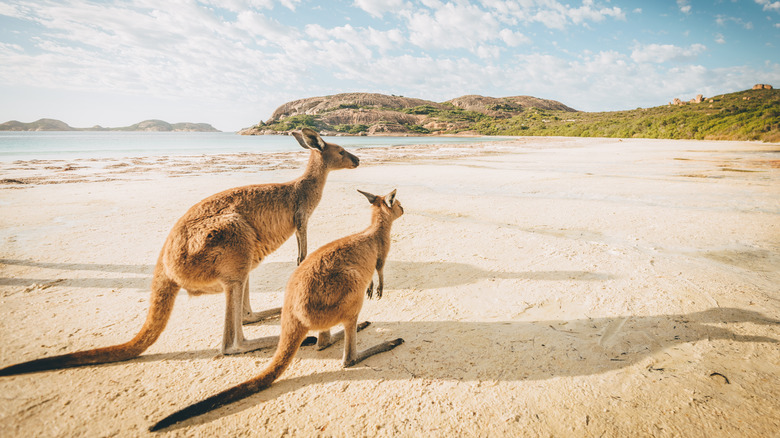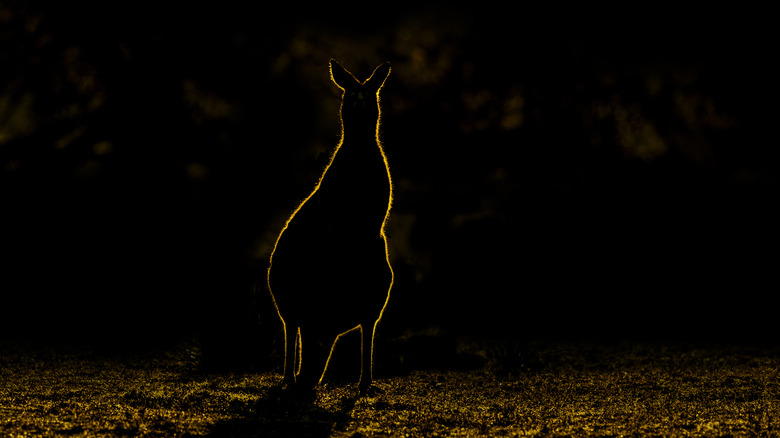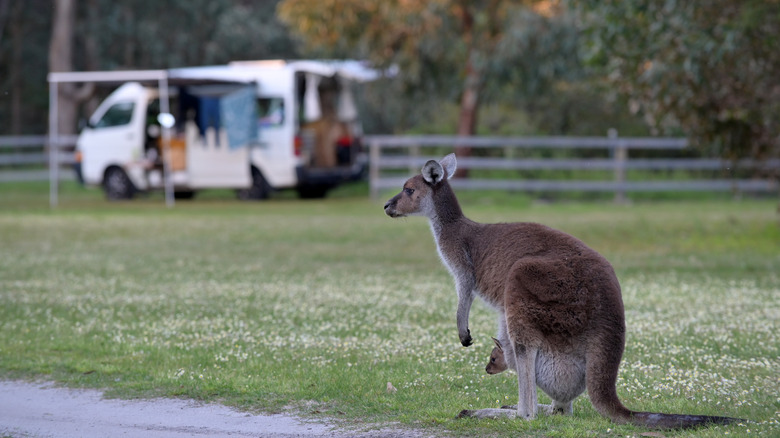A Creepy Detail About Kangaroos You Should Know Before Camping In Australia
Camping is one of the most thrilling adventures in Australia and might sound a bit daunting to the less adventurous among us. However, provided that you are well-equipped, know your route in advance, stay connected, and have a backup plan, there is no reason why you shouldn't have an incredible experience in the great outdoors. There are few better places to get away from the rat race than Australia's national parks, and you've always got those cuddly kangaroos to keep you company. There are around 45 million of the large marsupials in Australia (per CBS News), outnumbering Australians by almost two to one. That means there is a very good chance you will encounter them while camping, and you should be aware of one detail about the country's national animals: They make creepy noises when they walk.
The beloved kangaroo is an iconic symbol of Australia appearing on bank notes, postage stamps, and the long-running TV show "The Adventures of Skippy." Yet while we may picture them hopping across a scrubby landscape in bright sunshine, many species are largely nocturnal, taking shelter during the heat of the day and foraging at night or in the morning or late afternoon when it is cooler. This can cause some alarm if you are camping and unaware of what they sound like on the move. YouTuber Ridewithian posted a word of warning about this aspect: According to him, they resemble ominous footsteps stomping around nearby.
Why slow-moving kangaroos sound like someone walking
There are four species of kangaroo endemic to the country: red kangaroo, eastern grey kangaroo, antilopine kangaroo, and western grey kangaroo. Like their human neighbors, most tend to inhabit areas towards the coast — only the red kangaroos thrive in the parched Outback. Kangaroos have become so abundant that around 5 million are legally culled each year to keep numbers down (per Phys.org), and some chefs have controversially suggested that people should eat more 'roo meat. The short of it is that a road trip in Australia is unlikely to be kangaroo-free, especially if you are camping.
While kangaroos are more well known for the range of noises they make when communicating, the sound they make when they walk might come as some surprise. While traveling at speed, they bound forward with powerful thrusts of their oversized hind legs. A fully-grown adult can spring forward around 20 feet in a single leap and reach speeds of up to 40 mph. It is a different story when they are traveling slowly. They are unable to move their hind legs independently, so when they shuffle along at a reduced pace, they use their tails and short forelegs to move forward. They are powerful animals that can grow up to 8 feet tall and weigh up to 200 pounds, so the effect of this lolloping motion may sound a little like Jason Vorhees from the "Friday the 13th" movies looking for his next victim.
Where to camp with kangaroos in Australia
There are many excellent places across Australia where you can camp and see plenty of kangaroos. The Great Ocean Road in Victoria is one of the best places to build your bespoke Australian adventure, and the region is home to large numbers of eastern grey kangaroos. There are dozens of campsites to choose from, and it is worth taking time out for 18 holes at Anglesea Golf Club, which has a unique hazard on the links — the resident kangaroos hanging out beside the greens and fairways.
Further east (in New South Wales), you will find Murramarang National Park, another area that is great for camping. One of its most popular spots for kangaroo-spotting is Pebbly Peach, famous for its friendly eastern greys that enjoy grazing along the shore and even frolicking in the water. Further north on the coast of Queensland, Cape Hillsborough is a more secluded spot also well-known for its beach-loving kangaroos.
For a more far-flung kangaroo adventure, head out to Kangaroo Island off the coast of South Australia. It is known as a "zoo without fences," and there are around 65,000 smaller 'roos in residence, not to mention other wildlife like koalas, wallabies, and seals. Wherever you go camping in Australia, bear in mind that you shouldn't feed or touch wild kangaroos and be wary if they display aggressive behavior. While kangaroo attacks are rare, they have been known to injure people.


